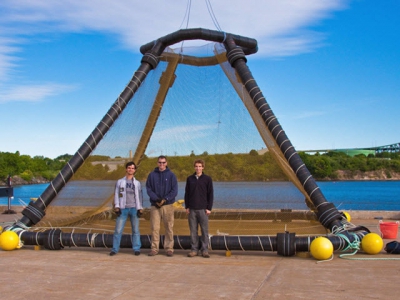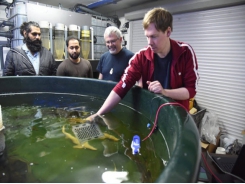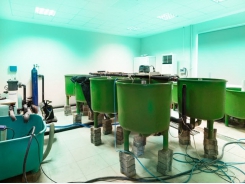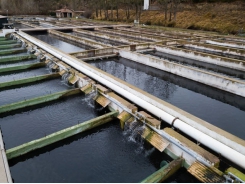Marine aquaculture with copper alloy nets

Sturdy nets resist biofouling but require design changes
Copper alloy net cages offer increased strength and maintenance advantages, but may require special engineering for integration with existing facilities.
Marine aquaculture is playing an increasingly important role in meeting the worldwide demand for seafood products. Growing fish in the marine environment advantages over pond and recirculation-based systems in terms of economic feasibility for small- and large-scale operations, growout site availability and reduced energy requirements.
The marine aquaculture industry also has its challenges, ranging from environmental concerns related to feed and fish waste, to loss of product due to predators and fish escapement, and maintenance requirements due to biofouling. The environmental concerns can be mitigated by proper feed and site selection – for example, by using soy-based ingredients to limit fishmeal use and locating farms outside sheltered harbors and bays. The latter challenges can be solved with technological advances such as the use of new predator-proof, biofouling-resistant materials for fish nets.
Polymer nets
The vast majority of marine fish farms employ netting made of polymers such as nylon, which is usually coated with an antifouling paint. While inexpensive, lightweight and flexible, the polymer nets are prone to large volume loss of a net chamber due to high currents and can be compromised due to predator attacks, leading to fish escape.
Biofouling can be a concern for longer growout cycles, as it reduces cage flushing rates, increases cage drag and mooring loads, and introduces areas with lower oxygen. The antifouling coatings typically have a service life of three to six months, after which scheduled net cleaning must be performed.
Promising technology
A promising technological solution to these problems is the use of copper alloy netting. These alloys are inherently biofouling-resistant, have higher strength and resistance to biting than polymer nets and have advantageous hydrodynamic properties.
Preliminary studies conducted by the University of New Hampshire in collaboration with the American Soybean Association and the International Copper Association have also shown no adverse biological effects on the health and growth rates of fish grown out in copper alloy netting.
However, the use of copper alloys presents some challenges to the industry, such as increased mass (which impacts everything from the strength requirements of the floating collar to net pen construction), material compatibility and wear if the material is not installed properly. Therefore, it is critical to better understand the performance of these alloys before they can be used on a greater scale.

The copper netting on the right resists biofouling. The geometry of chain-link nets is also characterized by low drag resistance.
Corrosion, biofouling studies
The authors performed a series of studies to quantify the biofouling resistance and material loss rates of copper alloys in seawater and investigate the hydrodynamic responses of copper alloy nets in the marine environment.
Quantifying the performance of copper alloys in marine environments is complex, as it depends on a number of environmental factors, such as flow velocity and circulation, water salinity, temperature, dissolved-oxygen and metal ion concentrations, and sunlight exposure. Even though accelerated laboratory testing and numerical simulations can provide useful information on material performance, accurate data estimates can only be obtained through field trials in locations with environmental conditions similar to those of the deployment site. Based on this data, one can evaluate the engineering and economic viability of using specific copper alloys for fabricating fish cage nets for marine aquaculture.
In 2011, the corrosion and biofouling performance of 11 copper alloys produced by several manufacturers in the United States, Germany and Japan was evaluated in a 12-month field deployment study in the North Atlantic Ocean. The alloys were supplied as plate specimens, woven and welded net meshes, and wire sections.
As part of the study, three reference materials – pure copper plates, mild steel plates and nylon nets – were also deployed for comparison of the results.
At the end of the study, the material loss was quantified via the changes in weight and dimension, and analysis of surface micrographs. Mechanical testing was conducted to evaluate degradation of material stiffness and strength. With no standard protocols available for evaluating the biofouling resistance, it was quantified in terms of biomass weight measurements, taxonomic compositions and visual observations.
Study results
The results of this research showed that most of the copper alloys exhibited material loss rates similar to those of pure copper and six to eight times lower than the corrosion rates of steel. All three of the copper alloys presently utilized in research and at commercial farms showed good resistance to corrosion. However, for some of the experimental alloys, significant local corrosion damage was observed, which might render them unsuitable for long-term use in marine aquaculture.
The biofouling resistance of most of the copper alloys tested was much higher than that of steel and nylon. No biofouling was observed on the majority of the copper alloys, whereas the steel plate and nylon net specimens experienced an increase in dry weight due to biofouling of 150 percent and 500 percent, respectively. The biofouling resistance has shown to be beneficial to farmers in Chile and Turkey by reducing the maintenance costs associated with cleaning and repairing the net.
Hydrodynamics
The further use of copper alloy netting in marine aquaculture will require systematic studies and better understanding of hydrodynamic performance. The drag forces on copper nets are different from those for traditional nylon netting because of the differences in material stiffness, surface roughness and strand arrangements.
To characterize the drag forces of various copper nets, laboratory experiments were conducted in a tow tank at different towing velocities. The testing was carried out for several net designs: chain-link fence, woven mesh, rectangular welded grid and expanded mesh.
It was observed that while the drag coefficients of expanded mesh exhibited the highest resistance, the drag for chainlink nets was approximately two times lower than that of nylon nets with similar projected area. Therefore, utilization of copper nets may result in lower forces acting on mooring lines and anchors.
In addition, a comparison study of volume loss for nylon and copper net chambers is presently under way. Preliminary results showed that copper net chambers retained their shape better than similar-sized nylon net pens due to the lower drag coefficients, and increased stiffness and weight.

Testing has shown that copper net chambers retained their shape better than similar-sized nylon net pens.
Cage design
The engineering approach to the design of fish farms with copper alloy netting is significantly different from the methodologies developed for systems with polymer nets. To assist with smooth integration of copper nets into the existing aquaculture infrastructure, the standard procedures for construction, deployment and recovery of aquaculture systems should be modified.
The technological challenges include the increased weight of netting, proper net attachment methods, material compatibility, system buoyancy and required cage construction infrastructure. The mass of copper nets requires higher structural strength in the cage framework. To insure a sufficient service life, copper net chambers must be properly secured to the cage frames to limit large amounts of relative motion.
Accelerated material loss rates may occur if dissimilar materials such as steel and copper are in contact in the seawater. Also, there is an additional difficulty in handling components during cage fabrication and deployment.
To address these challenges, proper engineering guidelines have been developed and tested through field deployments of copper net systems in the North Atlantic, South Pacific and Mediterranean Sea. They are presently being reviewed by Norwegian certification authorities.
(Editor’s Note: This article was originally published in the July/August 2012 print edition of the Global Aquaculture Advocate.)
Có thể bạn quan tâm
Phần mềm

Phối trộn thức ăn chăn nuôi

Pha dung dịch thủy canh

Định mức cho tôm ăn

Phối trộn phân bón NPK

Xác định tỷ lệ tôm sống

Chuyển đổi đơn vị phân bón

Xác định công suất sục khí

Chuyển đổi đơn vị tôm

Tính diện tích nhà kính

Tính thể tích ao hồ




 US: microalgae co-product may have role in cutting…
US: microalgae co-product may have role in cutting…  Nutritional programming may support farmed perch growth, fishmeal…
Nutritional programming may support farmed perch growth, fishmeal…